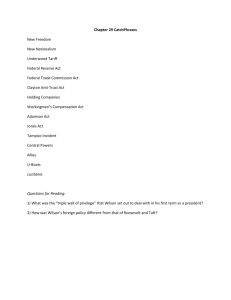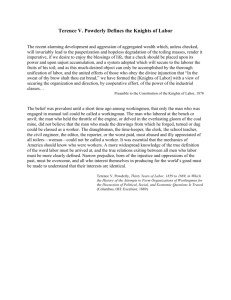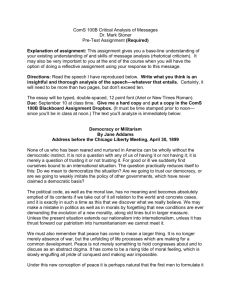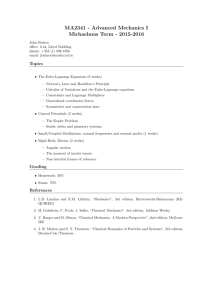Working Men's Parties of 1828-1831
advertisement
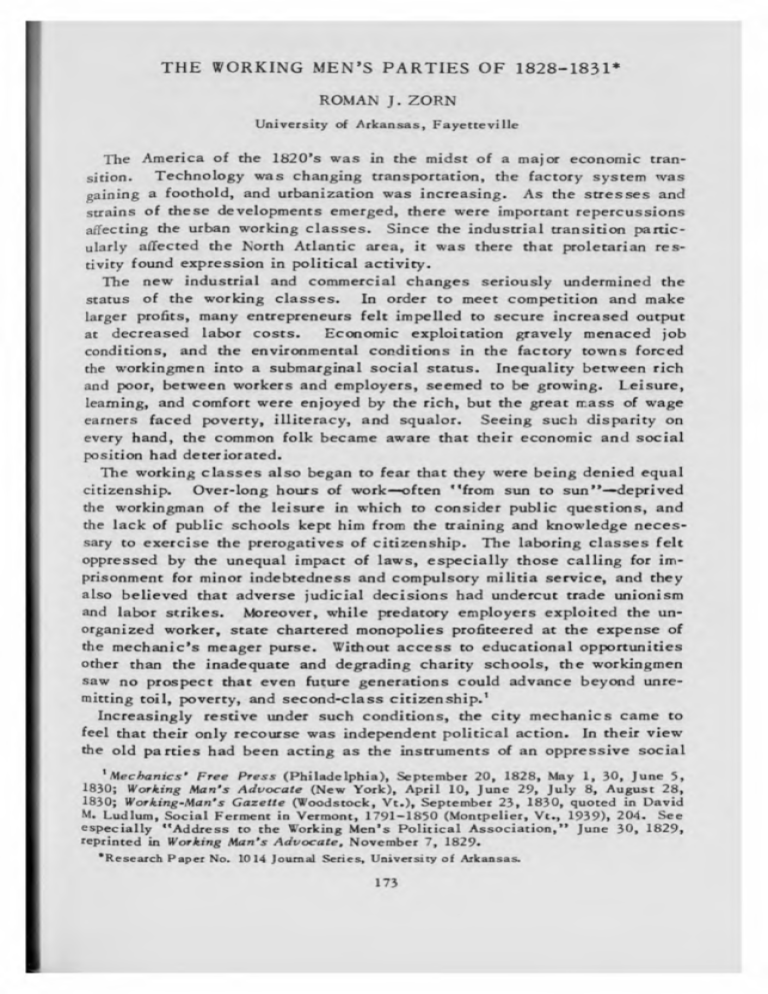
THE WORKING MEN'S PARTIES OF 1828-1831* ROMAN J. ZORN University of Arkansas, Fayetteville The America of the 1820's was in the midst of a major economic transition. Technology was changing transportation, the factory system was gaining a foothold, and urbanization was increasing. As the stresses and strains of these developments emerged, there were important repercussions affecting the urban working classes. Since the industrial transition particularly affected the North Atlantic area, it was there that proletarian restivity found expression in political activity. The new industrial and commercial changes seriously undermined the In order to meet competition and make status of the working classes. larger profits, many entrepreneurs felt impelled to secure increased output at decreased labor costs. Economic exploitation gravely menaced job conditions, and the environmental conditions in the factory towns forced the workingmen into a submarginal social status. Inequality between rich and poor, between workers and employers, seemed to be growing. Leisure, learning, and comfort were enjoyed by the rich, but the great mass of wage earners faced poverty, illiteracy, and squalor. Seeing such disparity on every hand, the common folk became aware that their economic and social position had deteriorated. The working classes also began to fear that they were being denied equal citizenship. Over-long hours of work often "from sun to sun" deprived the workingman of the leisure in which to consider public questions, and the lack of public schools kept him from the training and knowledge necessary to exercise the prerogatives of citizenship. The laboring classes felt oppressed by the unequal impact of laws, especially those calling for imprisonment for minor indebtedness and compulsory militia service, and they also believed that adverse judicial decisions had undercut trade unionism and labor strikes. Moreover, while predatory employers exploited the unorganized worker, state chartered monopolies profiteered at the expense of the mechanic's meager purse. Without access to educational opportunities other than the inadequate and degrading charity schools, the workingmen saw no prospect that even future generations could advance beyond unremitting toil, poverty, and second-class citizenship. 1 Increasingly restive under such conditions, the city mechanics came to feel that their only recourse was independent political action. In their view the old parties had been acting as the instruments of an oppressive social — — 1 Mechanics' Free Press (Philadelphia), September 20, 1828, May 1, 30, June 5, 1830; Working Man's Advocate (New York), April 10, June 29, July 8, August 28, 1830; Working-Man's Gazette (Woodstock, Vt.), September 23, 1830, quoted in David M. Ludlum, Social Ferment in Vermont, 1791-1850 (Montpelier, Vt., 1939), 204. See especially "Address to the Working Men's Political Association," June 30, 1829, reprinted in Working Man's Advocate, November 7, 1829. *Research Paper No. 1014 Journal Series, University of Arkansas. 173 174 ARKANSAS ACADEMY OF SCIENCE system, and many felt certain that a wise and independent use of the vote could ameliorate their grievances. 2 The resulting political revolts created the Working Men's Parties of 1828-1831. These parties, as would be expected, emerged in the major eastern cities of Philadelphia, New York, and Boston. The earliest organized workingmen's party appeared in the City of Brotherly Love in 1828. Prior to that year the Philadelphia mechanics had been concerned with a struggle to establish shorter hours of labor, but they gradually evolved an organized political movement designed to restore "equal citizenship" to the working classes. Their new party was destined to a life span of only four years, but it was to prove a pioneer example soon imitated in the towns of northeastern America. The unrest of the Philadelphia proletariat had come to a head in 1827 with the outbreak of a carpenters' strike to attain the ten-hour day. But the aspiration for shorter hours transcended the scope of any one trade, and general recognition of this situation constituted the basis for an integrated workingmen's movement. The result was an attempt to form a citywide organization of trade unions which could effect mutual aid and assistance. Thus, in late 1827, the Mechanics Union of Trade Associations was established. 3 This body, a prototype of the modern city trades federation, soon recognized possibilities of improving the status of the workingman via political action. Asserting that previous elections had centered control in the hands of a few without adequate representation of the working classes, the Mechanics Union polled its constituent unions on the question of nominating labor-endorsed candidates in the forthcoming elections for the city council and state legislature. After endorsement from the unions representing the cordwainers, hatters, and carpenters, the Mechanics Union overwhelmingly adopted a by-law providing for nominations for the fall elections. Thus emerged the first venture of American workers into politics under their own name and for their own benefit. 4 The decision for political action once made, the city organization called a series of four meetings to draft a platform and designate candidates. Their program emphasized eight major issues: they especially favored public support for educational facilities and the enactment of mechanic's lien laws; and they denounced imprisonment for debt, the compulsory militia system, chartered monopolies, the liquor industry, public lotteries, and the noteissue function of banks. Having defined their objectives, a slate of nominations was devised and "vigilance committees" were organized to promote l Mechanics' Free Press, April 17, June 5, October 2, 1830. See also Frederick Robinson, "Oration Delivered before the Trades' Union of Boston and Vicinity on the 58th Anniversary of American Independence" (Boston, 1834), 11; Seth Luther, "Address to the Working Men of New England" (3rd edition, Philadelphia, 1836), 5•For an authoritative account of the restivity of the Philadelphia mechanics, see John R. Commons, et al., History of Labour in the United States (4 vols., New York, 1918), 1: 185-192. *Mechanics' Free Press, April 19, May 31, August 23, October 29, 1828. 175 support. Thus prepared, the infant labor party turned to meet its test. 8 official first When the Philadelphia Working Men's Party crystallized in 1828, the National Republican Party controlled the city while the Democratic Party controlled the surrounding county. Despite such entrenched opposition, the labor-endorsed candidates made a good showing. Those candidates listed exclusively upon the workingmen's ticket received from 229 to 539 votes in the city and approximately 425 votes in the county. Those labor candidates who also had the backing of one of the orthodox parties averaged from 300 After the balto 600 votes ahead of their Working Men's Party colleagues. lots were counted it was apparent that the Democrats had carried every office in the city and county, and that the only labor-endorsed candidates who had been elected were the 21 who also served as Democratic nominees. However, due to belated and hasty campaign preparations, the workingmen had not expected complete victory. Their leading party organ thus observed, "the result has been equal to our most sanguine expectations; yet it may not be equally as satisfactory to our friends."* Encouraged by the outcome of their first efforts, the workingmen immediately prepared for further political action. They formed ward and district committees, and they integrated these local groups into city and county conventions. They also published an "Address to the Working Men of Philadelphia." Despite some internal dissension caused by "band-wagon" politicians, in 1829 they carried out a persistent campaign. 7 In consequence of these efforts, the 1829 referendum showed that the aggregate labor strength in both city and county had increased to approximately 2,400 votes. Of the 54 candidates the workingmen had supported, 20 (but all of whom had also received endorsement from other parties) now attained office. 8 So encouraging was this result that the Mechanics' Free Press declared, "the balance of power has at length got into the hands of the working people, where it properly belongs, and it willbe used in the future for the general weal.'" During the winter and spring of 1829-1830, the mobilization of proletarian political strength continued. The Philadelphia Association diligently publicized its principles and organization, and the result was a broadening of the movement outside the environs of Philadelphia. Gradually workingmen's parties emerged in Phillipsburg, Lancaster, Carlisle, Milesburg, Pottsville, Erie, and Harrisburg. By 1830, special city and county conventions were being inaugurated, and thus it seemed that the Working Men's Party was heading for state-wide organization. 10 political *Ibid., August 16, 23, October 4, 1828. See also Commons, op. cit., 1: 196, 217,218. "Mechanics' Free Press, October 18, 1828. See also Commons, op. cit., 1: 195, 198. Mechanics' Free Press, January 3, 10, 24, 31, February 21, 28, March 21, Au8, 17, 22, 26, September 7, 20, 26, October 3, 1829. 1 gust "Ibid., October 24, 1829. *Ibid., October 17, 18296, July 24, 31, August 7, September 11, 18, 1830. See also Delaware Free Press, July 31, September 18, 1830, and N. Y. Working Man's Advocate, February 13, July 14, August 7, 1830, as cited in Commons, op. cit., 1: 207, 209. xolbid., February 176 ARKANSAS ACADEMY OF SCIENCE From the beginning, however, the labor party had been obliged to fight for its continued existence. The old-line professional politicians, alarmed by the vigor of their new competitor, tried desperately to undercut the movement. Thus by 1830 there was already some internal weakness, due to an infiltration by self-seeking men who sought tc gain a foothold within the party and thence to use it as a political tool. More damaging, however, was external propaganda which slanderously attacked the movement. Charges of irreligion, "agrarianism," and radicalism were recklessly hurled against the labor party, and the consequent notoriety militated against any permanent success. 11 By late 1830, the workingmen's political movement was already on the retrograde. Despite some gain in the total labor vote cast that year, the prevailing anti-labor reaction caused the party to elect fewer candidates. 12 The 1830 results indicated that the labor party had lost the balance of power it once had held, and the conservative press now proclaimed "the death of workeyism." 13 This setback seriously undermined the morale of the Working Men's Party, and little is known of party activities during the winter and spring of 1830-1831. Apparently, however, some remnants held city and county conventions later in the year, and a slate of candidates was put up for the 1831 elections. In the 1831 referendum not a single laborendorsed candidate was elected to oiHce, and the average labor vote declined to less than sixty percent of the 1829 vote. 14 The zenith of the movement had long since been passed, and the party remnants had not been strong enough to cope with the distractions of the national campaign of 1832. After 1831 the Pennsylvania Working Men's Party was dead. New York was affected no less than Pennsylvania by the pervasive fears of a deteriorating status among wage earners. There, too, the workingmen were becoming resentful of economic exploitation and second-class citizenship; there, too, they felt that inequitable laws, domination by the aristocracy, and political bossism had aggravated the plight of the laborer. By the late 1820's, New York mechanics likewise felt it necessary to turn to independent political organization in order to restore the producing classes to "equal citizenship." The New York Working Men's Party, however, was distinguished from its Pennsylvania counterpart by the leadership of reformist "intellectuals." Not only did the doctrinaire concepts of Thomas Skidmore, Robert Dale Owen, Frances Wright, and George Henry Evans infiltrate the party, but they generated severe ideological dissension within the movement. In 1829, when the awakening of the New York proletariat began, one of the most militant agitators was Thomas Skidmore. This self-educated "See Mechanics' Free Press, February 6, April 24, June 19, August 1, 29, October 3, 16, 1830. "Ibid., October 16, 1830. 3 American Sentinel, October 13, 1830, quoted in Commons, op. cit., 1: 213. 14 Poulson's American Daily Advertiser, July 15, August 6, October 13, 1831, cited in ibid., 1: 214, 215. ' THE WORKING MEN'S PARTIES OF 1828-1831 177 a primitive form of agrarian communism,' 5 and he urged espouse a political crusade for social regeneration through land redistribution. Addressing the early meetings of the New York City mechanics, Skidmore contended that a bold political program would bring He casuistically argued better results than moderate, specific demands. attacked, relationships capitalistic employers should be property that if buy the reforms in order to off radical agrarian readily concede lesser would agitation. 11 Skidmore induced the urban mechanics to follow his leadership in the 1832 political campaign, but the resulting counterattacks upon "agrarianism" soon alarmed and alienated many of the workingmen. Subsequently repudiated by a majority of the mechanics, the Skidmorean disciples seceded to form a rival "splinter" party. Skidmore continued to propagandize through his organ, The Friend of Equal Rights, but after 1829 he no longer exerted 17 a major influence upon the New York Working Men's Party. In marked contrast to Skidmorean agrarianism was the program of the "State Guardianship" reformers. This faction, led by Frances Wright, Robert Dale Owen, and George Henry Evans, urged an educational panacea as the remedy for the problems of the working classes. Emphasizing that education was the highway to self-improvement and social progress, they advocated the education of all children in state operated boarding schools. 18 Effective propaganda through The Daily Sentinel and the Working Man's Advocate brought the Owenite element into control of the New York Working Men's Party during 1830, but over-insistence upon the "State Guardianship" policy soon generated opposition resulting in another party schism. Critics concentrated much opprobrium upon the agnostic, communal, and feminist heresies associated with the Owen-Wright leadership, and ultimately the "State Guardianship" faction lost its influence upon the workingmen 's movement. 19 In many other respects the case history of the New York Working Men's Party was similar to that of Philadelphia. With the exception of Skidmore's agrarian communism and the Owenite educational program, the specific political issues raised in New York were essentially the same as those raised in Pennsylvania. Here the workingmen likewise denounced imprisonment for debt, banks and bank currencies, and the militia system; and they also demanded the enactment of a mechanic's lien law and publicly supported schools. There were a few other issues pertaining to local conditions, but these never became of prime significance. 29 mechanic advocated the workingmen to Thomas Skidmore, "The Rights of Man to Property!" (New York, 1829), im. I6 See G. H. Evans, "History of the Working Men's Party," in The Radical, January, 1842. "Commons, op. cit., 1: 244-245; see also A. M. Schlesinger, Jr., The Age of Jackson (Boston, 1945), 181-184. 18 See The Free Enquirer (New York), July 24, 31, August 19, 26, September 3, 9, November 7, 27, 1829; The Daily Sentinel (New York), April 8, 9, 10, 12, 13, 14, 1830. See also R. W. Leopold, Robert Dale Owen (Cambridge, Mass., 1940), 92-93; V. R. Waterman, Frances Wright (New York, 1924), 193-195, 202-205. "Commons, op. cit., 1: 248-260; Leopold, op. cit., 92-98; Waterman, op. cit., I5See pass 202-205. 20 See list of "Working Men's Measures" at head of editorial column in Working Man's Advocate, October 30, 1830. See also Commons, op. cit., 1: 282. ARKANSAS ACADEMY OF SCIENCE 178 The workingmen's movement in New York began in April of 1829. In the face of an employer's attempt to undermine the ten-hour day standard, the unrest of the mechanics culminated in two public meetings. The immediate by-product was that the workingmen designated an interim "Committee of Fifty" to watch and safeguard employee rights against any overt action by employers. This militant attitude seems to have headed off trouble. 21 The spring and summer passed without untoward incidents, but in mid-October the "Committee of Fifty" summoned another general meeting. This assemblage decided to by-pass the organization of a city federation of labor and instead advocated direct and independent political action. Taking cognizance of the approaching November elections, the mechanics promptly endorsed a slate of candidates who would be likely to aid their interests. On October 19, 1829, the foundations of an independent labor party were established. 22 The infant party met with immediate support from the organized tradesmen, and at least three powerful local unions endorsed its candidates. Reflecting the prevailing optimism among the workers, George Henry Evans' new paper, the Working Man's Advocate, declared: "The working classes have taken the field and never willthey give up the contest till the power that oppresses them is annihilated." 23 Only one week remained for electioneering efforts, but the neophyte politicians proved fairly effective. The labor-endorsed ticket polled over 6,000 out of 21,000 votes, and one candidate for the state assembly attained election. 24 While this outcome fell far short of a triumph, it gave encouragement to the formation of a permanent workingmen's party. Although prompt efforts were made to build a permanent party organization, it proved difficult to create solidarity in the ranks of the workingmen. Another mechanics' convention called for a definite plan of mobilization, but the result merely produced factionalism. A majority of the mechanics, alarmed at the attacks made upon "agrarianism," sought to jettison Skidmore's leadership. When they proved successful in this maneuver, Skidmore's followers seceded to form a rival organization called the "Poor Man's Party." 25 The bulk of the workingmen thereupon followed the guidance of the Owen-Wright-Evans clique. Accepting the "State Guardianship" panacea, the workingmen proceeded to build an integrated ward organization within New York City.26 Party harmony, however, was short-lived. The conservative press also attacked the radical heresies of Owen and Miss Wright, and again the mechanics lost confidence in their party mentors. 21 Ibid., 1: 234-236. Accounts of both meetings were published in Working Man's Advocate, October 31, 1829. See also Morning Courier & N. Y. Enquirer, October 23, 1829 "Working Man's Advocate, October 31, 1829. "Ibid., November 7, 1829; N. Y. Daily Advertiser, cited in Leopold, op. cit., 88. man ' P ' CZ 209"212 ; Leopold, op. cit., 95-96; Commons, op. cit., 1: 242-244. "Ibid., 1: 245-246, 252. ° '-' 179 once more developed, and disagreement over the "State Guardianpl ship" an produced another schism. Thereafter both the "State Guardianship" and the "Anti-State Guardianship" factions claimed to represent the 27 true workingmen's movement. Meanwhile, early in 1830, the workingmen's movement had expanded outside of New York City. Organizations of "farmer, mechanics, and workingmen" developed considerable strength in Albany, Troy, and Syracuse; and similar organizations appeared in Rochester, Utica, Schenectady, Geneva, and Batavia. "Committees of Correspondence" served to build inter-city cooperation, and plans were made for a state convention which would pre8 pare for the fall elections.* The first state convention of the New York Working Men's Party met in Salina on August 25, 1830. Delegates from thirteen counties were present and enthusiasm ran high, but the decisions of the party convention ultimately caused dissension and disunity. The first problem concerned the seating of rival delegations from New York City; and when the "Anti-State Guardianship" faction won recognition, the Owenites withdrew their support of the convention. Moreover, when the party assemblage decided to offer its gubernatorial nominations to two veteran Democratic politicians, both theOwenite and Skidmorean factions announced that they would boycott the convention ticket. Subsequently both dissenting factions proceeded to devise separate slates of candidates." The election of 1830 proved a fiasco for the workingmen of New York. Three sets of nominees, each professing to be the true representatives of the laboring classes, participated in the campaign. To add to the confusion, at the "eleventh hour" the convention-endorsed gubernatorial candidates repudiated their sponsors and withdrew from the election contest. The rankand-file mechanics were perplexed and demoralized by these developments, and deep-seated factionalism ensured an overwhelming defeat at the polls.30 The election disaster culminated in the complete disintegration of the New York Working Men's Party. Only the Owenites tried to revive the party as a separate entity, and their efforts proved fruitless. Most of the mechanics returned to the Democratic party and a few others entered into coalition with the National Republicans. 31 Meanwhile the workingmen's movement had spread from New York and Pennsylvania to other states. It appeared chiefly along the Atlantic coast, but it extended westward as far as Missouri. Workingmen's organizations crystallized in most of the New England states, and also in Delaware, New Dissension "Ibid., 1: 256-260; Leopold, op. cit., 97-98. "Commons, op. cit., 1: 260-263. "Daily Sentinel, August 28, September 7, 1830; Working Man's Advocate, September 4, October 27, 1830; Morning Courier &N. Y. Enquirer, October 26, 1830. 30 The Democrats secured 10,000 votes, a coalition of National Republicans and conservative workingmen polled about 7,000 votes, the Owenites received only about 2,000 votes, and the Skidmorean ticket polled only slightly over a hundred votes. N. Y. Daily Advertiser, November 8, 1830, cited in Leopold, op. cit., 98. 3 *Ibid., 98; Schlesinger, op. cit., 184-185; Commons, op. cit., 1: 269-270. ARKANSAS ACADEMY OF SCIENCE 180 Jersey, Ohio, Indiana, and even South Carolina. Some fifty newspapers distributed over an area of fifteen states, expressed approval of the mechanics' political movement at some time between 1829 and 1832. 32 Throughout New England the lack of economic and political equality was the chief cause of proletarian complaint. Indeed, the disgruntled Yankee mechanics regarded "all attempts made to degrade the working classes as so many blows aimed at the existence of our free political and civilinstitutions." 3 By 1830, therefore, they were quite ready to turn to political organization. In New England the specific political objectives were practically the same as those desired by the workingmen's parties elsewhere: first came a demand for public support for education, and then came stipulations for specific political and economic concessions. 34 The chief agitators for labor reform in New England were Dr. Charles Douglas, Theophilus Fiske, and Seth Luther. Dr. Douglas was the proprietor of a labor paper, The New England Artisan, which he had founded at Pawtucket, Rhode Island in 1831; Fiske was the radical-minded editor of The New Haven Examiner; and Seth Luther was a peripatetic journalist and agitator who had many contacts with the workers in the industrial towns. There were also lesser lights: representatives of the Berkshire discontent were \V. S. Wait and W. W. Thompson, and the spokesmen for the workers of the Connecticut river towns included John B. Eldridge and Samuel Whitcomb, Jr. 35 The evidence concerning the organization of the New England workingmen's parties is fragmentary, but apparently the earliest centers of political agitation were New London, Connecticut, Woodstock, Vermont, and Plymouth, Massachusetts." By mid-1830 the political movement had made its appearance in every New England state. The greatest concentration of the movement, however, came in Massachusetts. Plymouth was the first town to give tangible expression to the new movement, but a similar upsurge developed in Boston after two labor papers began publication there in July, 1830. The Boston mechanics endorsed a slate of candidates in the city elections of December of that year, and their party kept some momentum by proposing a full legislative ticket in the general elections in the spring of 1831. And during the winter of 18301831, workingmen's associations emerged in most of the counties of the state. 37 The path trod by the New England proletarian party was not unimpeded, and their difficulties did not differ materially from those which had afflicted their Philadelphia and New York brethren. Charges of religious infidelity 32 33 Ibid., 1: 285. Working Man's Gazette, October 21, 1830, quoted in ibid., 1: 292 *lbid., 1: 298. 3 35 Sc hiesinger, op. cit., 149; see also Louis Hertz, "Seth Luther: Working Class Rebel" in New England Quarterly, 13: 401-415. 38 Ludlum, op. cit., 202-203; Schlesinger, op. cit., 149; Commons, op. cit., 1: 290. "Ibid., 1: 291. 181 and "agrarianism" embarrassed the party, and the machinations of orthodox politicians likewise sabotaged it. After a general decline during 1831, symptoms of a Bostonian resurgence led to the formation of the "New England Association of Farmers, Mechanics, and Other Workingmen." This in 1832-1833, but thereafter it was absorbed into re-created group flourished 38 Party. the Democratic The workingmen's parties in other states were comparatively obscure. There was some organized activity in Delaware; and sporadic symptoms of political protest appeared in New Jersey, Indiana, Ohio, and even inMissouri and South Carolina. These scattered labor groups followed the general pattern in objectives and policies; they also suffered under charges of radicalism; and they also were injured by external political manipulation. They did not develop a broad basis of support, and apparently no units survived beyond 1831. 39 The decline and disappearance of the early labor parties was the result of almost purely political causes. The workingmen had too little political experience to establish successful party organizations, and the heterogeneity of the party membership led to dissension over objectives and policies. The machinations of designing politicians who wormed their way into the movement further complicated internal difficulties. And externally the new workingmen's parties faced unscrupulous and unrelenting attacks by the oldline party machines. Moreover, in efforts to short-circuit their proletarian political rivals, the orthodox parties frequently incorporated labor reform policies into their platforms. Thus weakened from within and undercut from without, the workingmen's parties could not long survive. In spite of their immediate and apparent failure, the workingrr.en's parties of 1828-1831 were of some significance. To be sure they did not elect many candidates nor control many elections, but they did express the mechanics' determination to remedy their conditions and to put life into the abstract phrases of democracy. Through these vehicles the laboring classes forced their grievances into the foreground of public attention, and the result was that many abuses were eventually removed. Imprisonment for debt and compulsory militia service were soon abandoned; mechanic's liens and bankruptcy laws were enacted; and banking reforms and antimonopoly controls ultimately developed. Most important of all, however, the American free school system came into being. While these changes were not directly secured by the workingmen's parties, the agitation of 1828-1831 materially contributed to bring the reforms to fruition. Thus the allegedly "radical" Working Men's Parties helped promote measures which are now commonly accepted as essential attributes of the American way of life. 38 Ibid., 1: 291-294; Schlesinger, op. cit., 171. "Commons, op. cit., 1: 287-290, 296-297.
